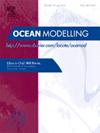波浪感应电流建模中表面滚子演化的参数化
IF 2.9
3区 地球科学
Q2 METEOROLOGY & ATMOSPHERIC SCIENCES
引用次数: 0
摘要
表面滚子是破碎波的陆上移动孔,储存了耗散的波浪能量,并延迟了能量向平均流的传递。传统的轧辊演化模型通常依赖于两个关键参数:轧辊斜率和能量传递分数,这两个参数通常被视为经验常数。然而,这种方法可能导致不现实或不准确的波浪感应电流模拟。在这项研究中,我们提出了参数化滚子斜率和能量传递分数的滚子演化方程中的波浪感应电流建模。对比了三种滚轮坡度参数化方法,根据其在各种条件下模拟波浪感应电流的性能,选择并修改了一种方法,以保证物理一致性和计算灵活性。在此框架的基础上,我们通过确定不同位置的最优值进一步细化了能量传递分数。随后使用这些值和局部波和水深参数进行最小二乘拟合,得到能量传递分数的有效参数化。模型评估表明,我们的滚子斜率和能量传递分数参数化为波浪感应电流建模提供了坚实的理论基础,与以往的方法相比,显著提高了模型的准确性和适用性。本文章由计算机程序翻译,如有差异,请以英文原文为准。

Parameterization of surface roller evolution in wave-induced current modeling
Surface rollers, which are onshore-traveling bores of broken waves, store dissipated wave energy and delay the transfer of energy to the mean flow. Traditional roller evolution models typically rely on two key parameters: the roller slope and the energy transfer fraction, both of which are often treated as empirical constants. However, this approach can result in unrealistic or inaccurate simulations of wave-induced currents.
In this study, we propose parameterizations for the roller slope and energy transfer fraction in the roller evolution equation for wave-induced current modeling. Three roller slope parameterization methods were compared, and on the basis of their performance in simulating wave-induced currents under various conditions, one method was selected and modified to ensure both physical consistency and computational flexibility. Building on this framework, we further refined the energy transfer fraction by identifying optimal values for different locations. These values and local wave and bathymetric parameters were subsequently used to perform least-squares fitting, yielding an effective parameterization of the energy transfer fraction.
Model evaluations demonstrate that our roller slope and energy transfer fraction parameterizations provide a robust theoretical foundation for wave-induced current modeling, significantly enhancing its accuracy and applicability, compared with previous methods.
求助全文
通过发布文献求助,成功后即可免费获取论文全文。
去求助
来源期刊

Ocean Modelling
地学-海洋学
CiteScore
5.50
自引率
9.40%
发文量
86
审稿时长
19.6 weeks
期刊介绍:
The main objective of Ocean Modelling is to provide rapid communication between those interested in ocean modelling, whether through direct observation, or through analytical, numerical or laboratory models, and including interactions between physical and biogeochemical or biological phenomena. Because of the intimate links between ocean and atmosphere, involvement of scientists interested in influences of either medium on the other is welcome. The journal has a wide scope and includes ocean-atmosphere interaction in various forms as well as pure ocean results. In addition to primary peer-reviewed papers, the journal provides review papers, preliminary communications, and discussions.
 求助内容:
求助内容: 应助结果提醒方式:
应助结果提醒方式:


